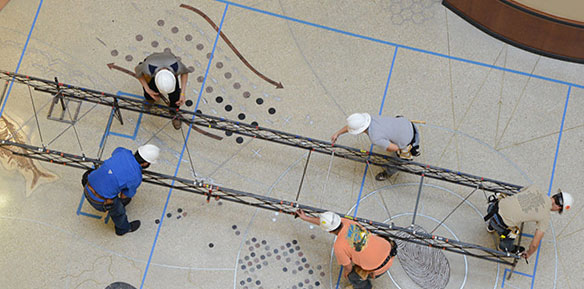Civil and Environmental Engineering faculty have expertise in a range of technical areas that include roadway infrastructure design, materials and management, hydraulic structures, structural composites, environmental engineering, geo-environmental modeling, and structural composites analysis. Funding sources include but are not limited to the National Oceanographic and Atmospheric Administration (NOAA), the Texas Department of Transportation (TxDOT), Texas Commission on Environmental Quality (TCEQ), NASA, and the National Science Foundation (NSF).
CEE faculty works closely with other faculty from the UTSA College of Engineering and College of Sciences to carry out research and collaborative initiatives.
Research Facilities
Civil Engineering laboratories are located in three buildings, as follows:
- Biotechnology Science and Engineering Building:
- Geomaterials Lab
- Environmental Engineering Lab
- Biotechnology Lab
- PC workstation Lab
- Engineering Building:
- Structures Lab (shared with the Mechanical Engineering Department)
- Geotechnical Lab
- Applied Engineering and Technology Building:
- The Hydraulics Lab
- PC Tablet Lab
Capabilities of each CEE Lab
The Geomaterials lab incorporates testing facilities for characterizing aggregates, asphalt binders, asphalt concretes, and soils. Major testing capabilities include:
- Brookfield Rheometer for determining asphalt binder flow characteristics.
- Dynamic Shear Rheometer (DSR) characterizes asphalt binder visco-elastic properties at high temperatures.
- Bending Beam Rheometer (BBR) for describing asphalt binder visco-elastic properties at low temperatures.
- Rolling Film Thin Oven for short-term asphalt binder aging.
- Pressure Aging Vessel for long-term binder aging.
- Gyratory Compactor for compacting asphalt concretes.
- Universal Testing Machine (UTM) is capable of uniaxial/triaxial testing, as well as indirect tension and flexural stiffness testing under temperature-controlled conditions.
- Wheel Rutting Device for accelerated determination of rutting resistance.
- Ignition oven for quick extraction of binder and binder content determination.
- Sieving system for aggregate grain size distribution.
- Miscellaneous specific gravity measuring devices.
- Asphalt binder and aggregate ovens.
It should be noted that the binder-related test procedures in this lab have been accredited by the American Association of State Highway and Transportation Officials (AASHTO) under the Materials Reference Laboratory (AMRL) program and it is certified under the AASHTO R18 Protocol ( www.amrl.org).
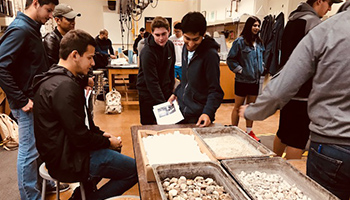
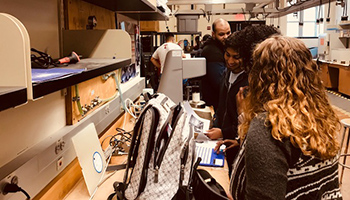
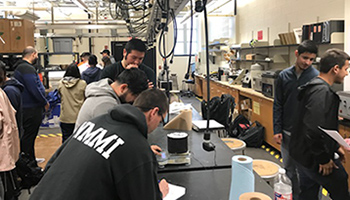

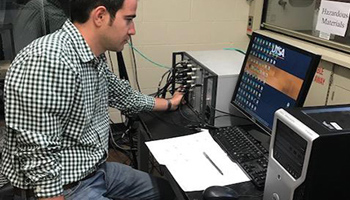

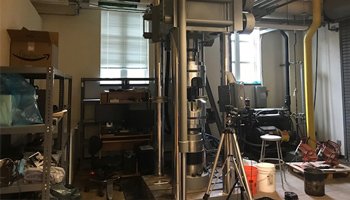
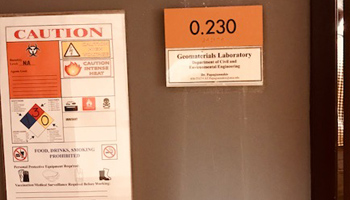
The Structures lab is shared between Civil and Mechanical Engineering. It includes the following major testing capabilities:
- Materials Testing System (MTS) with a capacity of 244 kN in axial and torsional loading
- Axial loading rig with a capability of 60 kN
- Shaker table with 2 degrees of freedom.
- Instron loading machine with a load rating of 600 kN
The Geotechnical lab includes the following testing capabilities:
- Six mechanical consolidometers
- Two direct shear machines with automated data acquisition capabilities
- Two pneumatic triaxial loading apparatuses with automated data acquisition capabilities
- Miscellaneous equipment for Atterberg limits, permeability measurements, and flow visualization
The Environmental lab includes the following testing capabilities:
- UV/Vis spectrophotometer for measuring ultraviolet and visible wavelengths
- Waters HPLC for separation of compounds on the basis of their polarity for identification, purity, etc
- Waters GC/MS for measuring organic chemicals by mass spectrometry
- Perkin Elmer ICP-OES measures in the mg/L range of most elements on the periodic chart by wavelength
- Perkin Elmer Elan DRC ICP-MS, measures in the µg/L range many elements on the periodic chart by using mass spectrometry
- Beckman Coulter DelsaNano measures particle size by dynamic light scattering and zeta potential
- Beckman Multisizer 3 measures particle size through sieving
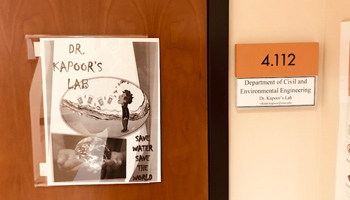
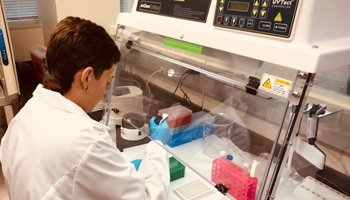
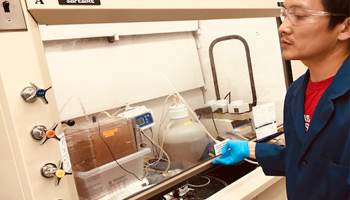
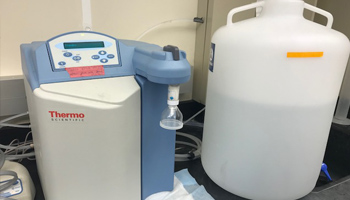
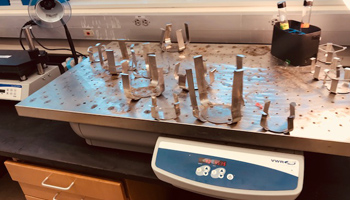

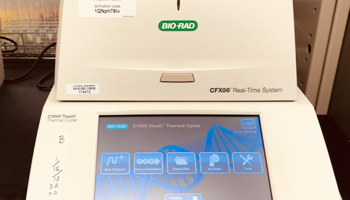
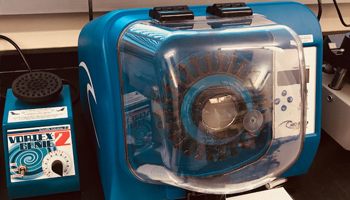
The hydraulics lab includes the following testing capabilities:
- One hydraulic flume for teaching purposes
- One hydraulic flume for research purposes
- One wind tunnel and
- One hydraulic hummer apparatus
It includes the following testing capabilities:
- Real-time PCR system
- Dcode system (for DGGE)
- 2 Class II Biosafety cabinets
- Regular PCR with temperature ingredient
- Inverted microscope
- Nanodrop spectrophotometer
- UVP BioDoc -it imaging workstation
- CO2 incubator
- Freeze drier
- Microcentrifuge
- Ultracentrifuge
- Freezer -80 C
- Freezer - 20 C
- X-ray film cassette with an intensifying screen
- Balance 0-1200g (Mettler Toledo XP series)
- Electronic top loading balance (Mettler Toledo Model XP6002MDR)
- Pipettors of various volumes (including multi-channel)
- 2 Gel apparatuses for running protein samples (XCell SureLock™ Mini-Cell)
- Orbital Shaker
- Flake Ice maker
The Concrete lab includes the following testing capabilities:
- Three hydraulic compression/indirect tension machines
- One saw for portioning concrete samples
- One drill for drilling asphalt concrete cores from 150 mm to 100 mm diameter
- Mixers and curing baths
This houses the activities of the ASCE student chapter concrete canoe and steel bridge competition, as well as testing facilities for the CE3242 course (Properties/Behavior of Engineering Materials).
Incorporated in the Geomaterials Lab, this lab has levels, transits, and total stations capable of accommodating 5 groups of four students simultaneously.
The PC lab includes workstation for 38 students. It is used extensively for teaching a number of computer intensive courses. The specialized software maintained on these machines includes:
- Highway Capacity Software
- Everseries pavement design software
- ANSYS 11.0
- ANSYS Workbench
- AutoCAD 2008
- BloodShed Dev C++ 5 beta 9
- ComSol 3.4
- CADopia IntelicCAD 4
- EverFe 2.22
- M-E Pavement Design Guide
- ProVAL 2.7
- LTPPBind v3.1
- PCAWIN
- CygWin
- eDrawings 2007
- Engineering Equation Solver
- Bentley
- HEC
- Interactive Thermodynamics v2.0
- Mathcad 13
- MatLab R2007b
- National Instruments Datasocket
- National Instruments Control Design Toolkit
- National Instruments Advanced Signal Processing toolkit
- National Instruments LabVIEW 8.2
- National Instruments System Identification Toolkit
- National Instruments Modulation
- National Instruments Motion Assistantv
- National Instruments Session Manager
- National Instruments SignalExpress
- National Instruments Spectral Measurements
- Primavera Software
- SolidWorks 2007
- OrCAD 15.7
- WMS 8.0
- SimTraffic 7
- Synchro 7
- SAP2000
The lab includes a large plotter that is used by students to produce posters for their CAD and senior design courses.
The hydrometeorology lab supports primarily research needs. It is equipped with a precipitation sensing radar installed on the roof of the Sciences Building (SB). Cloud and precipitation data are input into hydrological models for predicting flooding. The software for these simulations was developed under NOAA funding. The major pieces of equipment involved are:
- a radar
- two research rain gauges with batteries and data loggers
- two desktop computers and
- one laptop computer
ArcGis software is installed in these computers used for GIS applications. Since 2006, a total of $39k has been invested in equipping this lab.
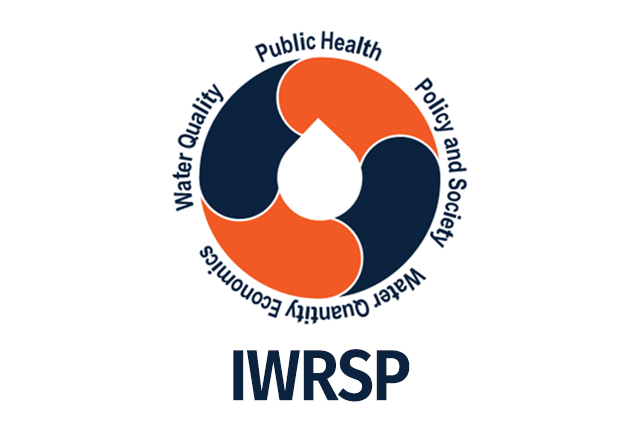
Institute for Water Research, Sustainability and Policy Lab
CEE faculty works closely with the IWRSP Lab, and other faculty from the UTSA College of Sciences to carry out our research under the new Doctoral program in Environmental Science and Engineering.
Have an inquiry about our program?
We appreciate your interest in the School of Civil & Environmental Engineering, and Construction Management at UTSA and extend our warmest welcome to you from the Department.


